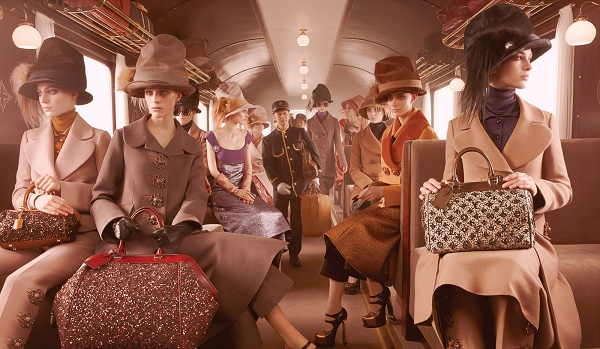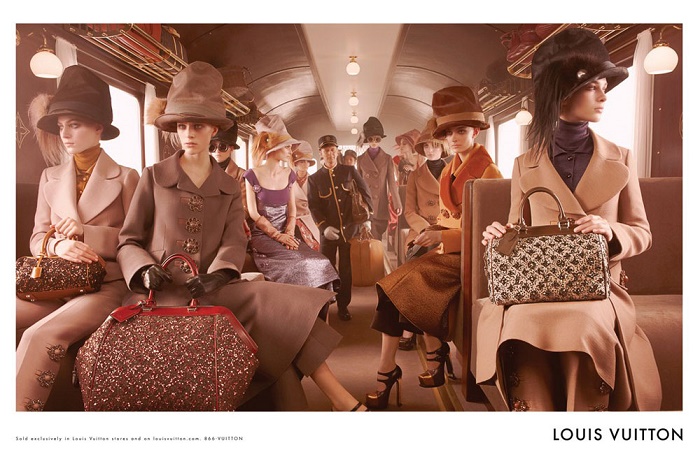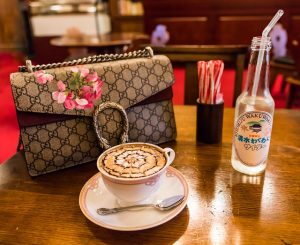
Da Parigi a Pechino: la moda viaggia sul Trans-Siberian Express
Di Virginia Angius – studente – Culture e Tecniche della Moda
Dall’Orient Express al moderno Eurostar passando per la Transiberiana. Il treno è qualcosa di più di un semplice mezzo per spostarsi o per recarsi ogni giorno al luogo di lavoro: nasce per unire e per dividere, per collegare e per creare confini. Ma soprattutto, il treno simboleggia l’avventura. E con lei la possibilità di scegliere dove partire e dove arrivare, fermarsi a osservare il paesaggio, incontrare i popoli di terre lontane, inseguire il sole correndo verso est, da Parigi a Pechino, dalla Russia alla Mongolia, attraversando in pochi giorni nove fasce orarie.
Il passaggio privilegiato per arrivare in Oriente è la ferrovia Transiberiana e chi ha l’anima del viaggiatore, come la maison Louis Vuitton, lo sa. Infatti, nel 2012 il fotografo Todd Selby è salito sul Louis Vuitton Express e, come i commercianti e gli esploratori di epoche lontane, partì da Parigi per un viaggio che lo condusse fino a Shanghai. Trascorrendo sul treno due intere settimane, passò proprio per quella stessa ferrovia, sulle orme del collega Norbert Schoerner, che nel Dicembre 2005 firmò un servizio fotografico per Vogue UK – dove non a caso apparivano articoli LV – interamente ambientato sul Trans Siberian Express. Marc Jacobs, in parallelo a Selby, si è ispirato alla Transiberiana e all’epoca d’oro dei viaggi su rotaie per realizzare l’intera collezione Louis Vuitton FW 2012; è qui che fa la sua prima comparsa la borsa in pelliccia di capra Transsiberian, vendendola così apparire sia durante le sfilate ready-to-wear di Parigi – dove le modelle sono state viste “sbarcare” da un vero treno a vapore – sia nella Fall Campaign 2012, ambientata proprio su un treno di lusso e immortalata dall’obiettivo di Steven Miesel.
Ma la linea ferroviaria non è stata l’unica fonte di ispirazione per gli stilisti occidentali, dal momento che tutto lo stile est-europeo, di oggi e di ieri, è stato bacino da cui attingere per le proprie creazioni: da Yves Saint Laurent e la sua “Russian Collection” del 1976 – ispirata a Leon Bakst e i balletti russi – a Frida Giannini per Gucci F/W 2008 fino al brand Issa London che per la collezione F/W 2012 ha proposto una donna viaggatrice, vestita di pellicce russian-inspired e riferimenti decò, che percorre il viaggio Transiberiano da Mosca a Pechino. Appare chiaro quanto l’Occidente debba molto non solo all’Oriente propriamente detto, ma anche all’est-Europa. La nostra è un’epoca in cui il passaggio di informazioni da un angolo all’altro del mondo è così immediato che sta causando da un lato l’omologazione degli stili e dall’altro la proliferazione di un numero potenzialmente infinito di “voci fuori dal coro”. In questo contesto, molti designer tendono ad attingere alle loro stesse origini per valorizzare le tradizioni del loro paese in modo moderno e giovane, senza scadere nel passatismo o nel folklore, e per ricordarci quanto di buono c’è nella storia dei loro singoli paesi. Un esempio per tutti è Anastasia Romantzova, creatrice del brand A la Russe, che “si appella alla cultura Russa, assorbendone i motivi delle influenze Europee e Asiatiche e preservando la sua naturale identità culturale”. Questa designer, così come tutti gli artisti cosmopoliti e globetrotter che del farsi trasportare e influenzare da culture diverse hanno fatto la loro filosofia – filosofia perfettamente incarnata dal mito del treno – ci insegna che la cosa più importante del viaggiare non è la provenienza o la destinazione, ma il viaggio stesso. E per chi non ha la possibilità di viaggiare fisicamente, c’è sempre la fantasia.
Source: www.vogue.co.uk, www.alarusse.ru; ph. www.haberdasherstandard.com.
_________________________________
From Paris to Beijing, Fashion travels on the Trans-Siberian Express
From the Orient Express to the modern Eurostar, going through Trans-Siberian railway. The train is something more than simple means of transport to go to work every day: it comes to join and to divide, to connect and to create boundaries. Above all, train symbolizes adventure: the chance to choose where to leave and to arrive, the chance to choose when to stop to watch the views or to meet different people. Train is the wonder of going after the sun, running toward East from Paris to Beijing, passing in a few days through Russia and Mongolia across nine time zones.
The best way to move to East is the Trans-Siberian Railway and the traveller souls, such as Louis Vuitton brand, know it well. Indeed, in 2012 the photographer Todd Selby gets on the Louis Vuitton Express and, like the ancient explorers and merchants, he left from Paris to arrive at Shanghai. He spent two weeks on the train and he went through that railway, like his colleague Norbert Schoerner did in 2005, when he signed a Vogue UK shooting – also showing LV items – entirely set on the Trans-Siberian Express. At the same time as Selby, Marc Jacobs, inspired by the golden age of railways and by the same Trans-Siberian, realized for Louis Vuitton a fabulous FW 2012 collection. On this occasion, he designed the Transsiberian PM bag, totally covered by goat fur: it appeared during the Paris fashion week on March 2012, where the models get off an actual steam train, and in the fall campaign 2012, located on a luxury train.
However, the Russian railway is not the only source of inspiration for Western designers. The whole East-European style is a tank of ideas and references that many fashion designers use to draw their ready-to-wear collections. For instance Frida Giannini for Gucci F/W 2008, Yves Saint Laurent and his 1976 “Russian Collection”, inspired by Leon Bakst and Russian Ballets, or Issa London brand that proposed a traveller woman for the F/W 2012 collection. A woman that leaves for “a Trans-Siberian journey from Moscow to Beijing and it is very Russian-inspired and then there’s Mongolian fur and then a Chinese part, going on to Art Deco”. In our era, news and information propagate and spread so quickly that, on one hand, the uniformity of the styles increase and, on the other hand, the diffusion of an unlimited number of new and signal voices get more possible. In this contest, many designers tend to draw from their native costumes. They avoid folklore or simple fogydom and translate their tradition in an innovative way, reminding us how much wonderful are their countries. An example is Anastasia Romantzova, founder of the brand A la Russe, which “appeals to the Russian culture, absorbing the motifs of European and Asian influences and preserving its own natural and cultural identity”. Like all cosmopolitan artistes and globetrotter whose philosophy is uniting different cultures and influences – philosophy perfectly represented by the myth of the train – this designer teaches us that the most important aspect of a travel is not the origin or the destination, but the travel in itself. And for who can’t physically travel, there still is imagination.

 Previous Post
Previous Post


